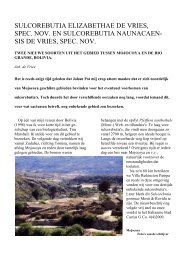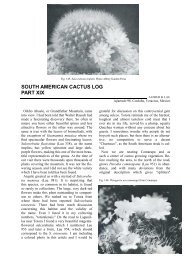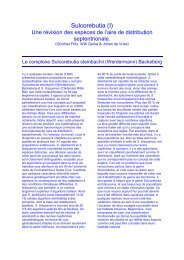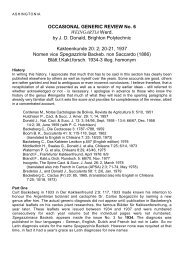Sulcorebutia, food for taxonomists?
Sulcorebutia, food for taxonomists?
Sulcorebutia, food for taxonomists?
Create successful ePaper yourself
Turn your PDF publications into a flip-book with our unique Google optimized e-Paper software.
Some projects<br />
Data, immediately apparent from observing the plant, turned out to lead to shaky conclusions<br />
as you can see from the above remarks. This may be made even clearer by the next example.<br />
A plant in the greenhouse of Karel became 15 cm high. A cutting of this plant which I<br />
received got to only 10 cm. Circumstances and care influence the outward appearance.<br />
Buxbaum had restricted himself to characteristics of flower and seed as these would always<br />
represent „primitive“ characteristics, meaning that the pressure of the environment would<br />
have less effect on them.<br />
A further clarification: if a certain characteristic is found on several plants of the whole group,<br />
it can be interpreted to be „primitive“. It is unlikely that such a characteristic came into being<br />
many times at different places independently of each other.<br />
One can wonder if a characteristic easily changes from one manifestation into another and<br />
afterwards back into the original, creating a kind of blinking light situation. Let us start with a<br />
population, of which all plants have brownish black spines. By a favourable mutation this<br />
population will obtain only white spined plants. But after some generations a next mutation<br />
causes only brownish black spines again.<br />
Nobody will take such a story to be probable but<br />
rather assume that the brownish black spine of<br />
the first population, <strong>for</strong> example <strong>Sulcorebutia</strong><br />
mentosa (Fig. 13), is a primitive characteristic.<br />
Likewise the white spine in the other<br />
population, <strong>for</strong> example <strong>Sulcorebutia</strong> albissima<br />
(Fig. 14) will be a primitive characteristic.<br />
There is no known report of a population in<br />
which both <strong>for</strong>ms appear, next to each other. In<br />
the Cites Checklist is S. albissima taken as a<br />
synonym of S. mentosa. By the text above I do<br />
not intend to deny a relationship. I simply cannot<br />
understand the decision to avoid the name<br />
„albissima“. Was this choice purely subjective?<br />
All statements about relationships are based on<br />
probability. There<strong>for</strong>e all of them are<br />
hypotheses. One can wonder how to evaluate a<br />
hypothesis when faced with evidence that in<br />
view of the hypothesis is improbable.<br />
Meanwhile the magic word seemed to be DNA,<br />
but this was not a realistic approach <strong>for</strong> the<br />
common amateur.<br />
In 2004 I was a member of a group of<br />
enthusiastic amateurs who tried to investigate<br />
relationships, using selected isoenzymes. One<br />
can take the characters of these isoenzymes to<br />
Fig. 13. <strong>Sulcorebutia</strong> mentosa JD175b<br />
Fig. 14. <strong>Sulcorebutia</strong> albissima JK 39<br />
be primitive. After all, if a mutation is not favourable, there is serious chance, that the<br />
individual with such a mutation will have died because of a failing digestion, be<strong>for</strong>e it got<br />
descendants.<br />
The result of comparing of isoenzymes showed that <strong>Sulcorebutia</strong> is less similar with Rebutia,<br />
but it was not really possible to separate it from Weingartia. Would Brandt be declared right<br />
after all?<br />
Some participants did not appreciate the results of the project very much, perhaps because it<br />
often did not confirm their postulated relationships. Of course one can question the







